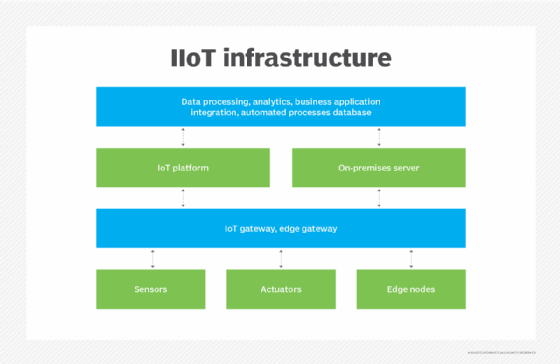Industry 4.0
Industry 4.0, which refers to the fourth industrial revolution, is the cyber-physical transformation of manufacturing. The name is inspired by Germany's Industrie 4.0, a government initiative to promote connected manufacturing and a digital convergence between industry, businesses and other processes.
History and evolution of Industry 4.0
The first industrial revolution took place at the end of the 18th century and was marked by mechanization made possible by steam and water power. The second industrial revolution, which occurred at the start of the 20th century, was aided by electricity and marked by mass production, assembly lines and divisions of labor. The third, around the start of the 1970s, came through the use of computers to further automate machines and production processes.

What is Industry 4.0 and the fourth industrial revolution?
The fourth industrial revolution might best be described as an extension of the third industrial revolution. Whereas Industry 3.0 introduced computers into the manufacturing process, Industry 4.0 focuses on connecting those computers to one another. However, Industry 4.0 goes far beyond systems on the factory floor being able to communicate with one another. When fully applied, Industry 4.0 allows for the creation of smart factories and enables digital manufacturing.
Industry 4.0 and IoT
One of the major technological trends of the last decade has been the adoption of IoT technologies. IoT essentially refers to the ability to connect non-traditional computing devices to the internet or to private networks.
Although the term is often used broadly, IoT often refers to smart, connected, consumer devices. However, manufacturers have also adopted the concept and have begun deploying large numbers of connected smart sensors in manufacturing centers. The use of such sensors is often referred to as Industrial IoT (IIoT).
IIoT is a key enabler of Industry 4.0, but Industry 4.0 also commonly uses other connected technologies such as smart machines and cyber-physical systems. All of these systems work together to achieve levels of automation that weren't previously possible.

What are the applications of Industry 4.0?
Industry 4.0 can be applied to all levels of the manufacturing process from product development to product end of life. Additionally, some manufacturers apply Industry 4.0 concepts to external resources such as supply chains, thereby enabling them to better anticipate supply disruptions, while also making it easier to source all of the materials used in the manufacturing of a product.
Another way that Industry 4.0 is applied is acquiring real-time data in manufacturing. This data can then be analyzed in an effort to optimize operations. This can improve efficiency and reduce the time to market, while also increasing the organization's productivity.
What technologies are driving Industry 4.0?
Industry 4.0 is driven by the convergence of technologies, including the following:
- IIoT and the widespread use of sensors;
- big data and analytics;
- artificial intelligence and machine learning;
- LPWANs for machine-to-machine and IoT networks;
- IT/OT convergence;
- touch and voice interfaces and augmented reality systems;
- advanced robotics; and
- additive manufacturing.
Essentially, all the new and developing technologies created for humans to communicate with machines, for machines to communicate with each other and to achieve more complicated goals, and for data to inform and optimize all the processes related to the manufacturing sector will interconnect manufacturing processes from design through the end of the product lifecycle.
What are the benefits of Industry 4.0?
Industry 4.0 provides numerous benefits to organizations that choose to implement it fully.
One such benefit is that Industry 4.0 concepts can enable OEMs to see how customers really used a product versus how it was expected it to be used.
Another benefit is that sensor data can help an organization to monitor the manufacturing process in real time. This data can then be compared against a digital twin -- a simulation that runs at perfect efficiency -- to determine where the process could be improved.
Some organizations have also applied Industry 4.0 concepts to their employee training process. These training programs use augmented reality to teach employees how to operate machinery and how to avoid unsafe practices before the employee is ever allowed on the factory floor. Some organizations even extend augmented reality-based training to other areas such as fire suppression and first aid.
Another benefit to Industry 4.0 is that its principles can help organizations avoid an outage on the factory floor. Prior to the adoption of Industry 4.0, industrial machinery was serviced based on manufacturer recommendations. However, Industry 4.0 has enabled machinery to be equipped with sensors that monitor the machinery's health on an ongoing basis. This enables organizations to anticipate problems before they occur and proactively take corrective action. In some cases, the machinery can even automatically place an order for replacement parts. All this together can help an organization avoid a costly outage that disrupts the manufacturing process.
One more benefit to applying Industry 4.0 concepts is that because the digital technology used on the factory floor is tied to back-end corporate data systems, it allows big data analytics to be performed on the data that is associated with the manufacturing process. Such analytics can help the organization spot trends and gain insights that might ultimately help it become more profitable.
What are the challenges of Industry 4.0?
Early on, the main challenges for organizations wishing to implement Industry 4.0 were cost and interoperability. The machines and sensors used on the factory floor often relied on differing protocols, making communications between connected devices difficult. However, standards begun to emerge as Industry 4.0 saw greater adoption.
Another major challenge related to Industry 4.0 is cybersecurity. In the past, the systems used on the factory floor tended to be proprietary in nature, and it was rare for such systems to be connected to one another or to back-end IT systems. As such, the vendors who created such systems rarely took a security-first approach to their development efforts.
Connectivity between devices and IT resources can expose these devices to the same cyber threats that have long plagued traditional IT devices. Additionally, a compromised IT system can provide an attacker with a path through which to attack the resources used on the factory floor.







